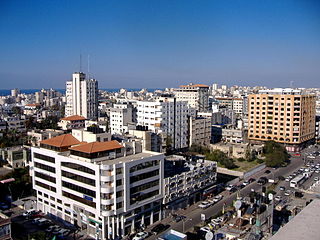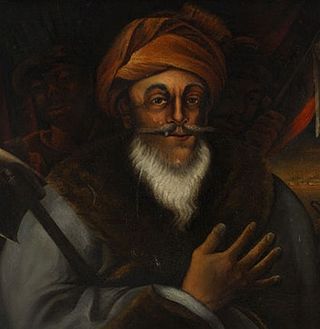
Gaza, also referred to as Gaza City, is a Palestinian city in the Gaza Strip, with a population of 590,481, making it the largest city in the State of Palestine. Inhabited since at least the 15th century BCE, Gaza has been dominated by several different peoples and empires throughout its history.

Al-Manshiyya, was a Palestinian village with a Muslim orphanage and a mosque known as the mosque of Abu 'Atiyya, which is still standing.

Izz al-Din Aybak was the first of the Mamluk sultans of Egypt in the Turkic Bahri line. He ruled from 1250 until his death in 1257.

Shajar al-Durr, also Shajarat al-Durr, whose royal name was al-Malika ʿAṣmat ad-Dīn ʾUmm-Khalīl Shajar ad-Durr, was a ruler of Egypt. She was the wife of As-Salih Ayyub, and later of Izz al-Din Aybak, the first sultan of the Mamluk Bahri dynasty. Prior to becoming Ayyub's wife, she was a child slave and Ayyub's concubine.

Ahmed Pasha al-Jazzar was the Acre-based Ottoman Bosnian governor of Sidon Eyalet from 1776 until his death in 1804 and the simultaneous governor of Damascus Eyalet in 1785–1786, 1790–1795, 1798–1799, and 1803–1804. He began a military career in Egypt in the service of mamluk officials, eventually becoming a chief enforcer and assassin for Ali Bey al-Kabir, Egypt's practical ruler. He gained the epithet of al-Jazzar for his deadly ambush on a group of Bedouin tribesmen in retaliation for the death of his master in a Bedouin raid. Al-Jazzar fell out with Ali Bey in 1768 after refusing to take part in the assassination of one of his former masters. He ultimately fled to Syria, where he was tasked with defending Beirut from a joint assault by the Russian Navy and Zahir al-Umar, the Acre-based ruler of northern Palestine. He eventually surrendered and entered Zahir's service before defecting from him and fleeing with stolen tax money.
Bani Zeid is a Palestinian town in the Ramallah and al-Bireh Governorate of Palestine, in the north-central West Bank, located 27 kilometers (17 mi) northwest of Ramallah, about 45 kilometers northwest of Jerusalem and about 6 kilometers (3.7 mi) southwest of Salfit. A town of over 6,000 inhabitants, Bani Zeid was founded when the villages of Deir Ghassaneh and Beit Rima merged to form a municipality in 1966 during the Jordanian rule.

The Great Mosque of Gaza, also known as the Great Omari Mosque is the largest and oldest mosque in the Gaza Strip, located in Gaza's old city, in the State of Palestine.
The Ibn Marwan Mosque is a Mamluk-era mosque in Gaza in the midst of a cemetery in the Tuffah neighborhood, relatively isolated from the rest of the city. Inside is the tomb of a holy man named Sheikh Ali ibn Marwan who belonged to the Hasani family. The Hasani family came from Morocco and settled in Gaza where Ibn Marwan died in 1314 CE. The cemetery is also named after Ibn Marwan. The mosque itself was built in 1324. The Ibn Marwan Mosque contains an oratory and the stones of the tombs in the adjacent cemetery are believed to contain historical inscriptions.
Sheikh Radwan is a district of Gaza City located nearly 3 kilometers (1.9 mi) northwest of the city center. It borders al-Shati camp to the southwest, Rimal to the south, and Jabalia to the east. The Sheikh Radwan Cemetery is located in the district. It contains hundreds of graves for Palestinians killed in the Israeli–Palestinian conflict, including Hamas leaders Ahmed Yassin, Abdel Aziz al-Rantissi, and Said Siam.
Tuffah is a district of Gaza City, located northeast of the Old City and is divided into eastern and western halves. Prior to its expansion and the demolition of the Old City's walls, Tuffah was one of the three walled quarters of Gaza, the other two being al-Daraj and Zeitoun. Tuffah was situated in the northeastern section of the Old City. The local pronunciation of the district's name is at-tuffen.

The Ibn Uthman Mosque is a mosque in Gaza City, in the Gaza Strip, Palestine. It is regarded as second only to the Great Mosque of Gaza in terms of beauty and status as a Friday mosque. Noted for its architectural patterns, the mosque was established in three different stages during the Burji Mamluk period of rule in Gaza.

Dayr al-Shaykh, also spelt Deir esh Sheikh, was a Palestinian Arab village in the Jerusalem Subdistrict, also known as the Jerusalem corridor. It was depopulated during the 1948 Arab-Israeli War. The village was located 16 kilometers (9.9 mi) west of Jerusalem.

Mujīr al-Dīn al-ʿUlaymī (1456–1522), often simply Mujir al-Din, was a Jerusalemite qadi and historian whose principal work chronicled the history of Jerusalem and Hebron in the Middle Ages. Entitled al-Uns al-Jalil bi-tarikh al-Quds wal-Khalil, it is considered to be invaluable, constituting "the most comprehensive and detailed source for the history of Jerusalem" written in its time.

Al-Daraj or Haraat al-Daraj is the densely populated northwestern quarter of Gaza's Old City. Its name translates as "Quarter of the Steps." Situated on an oblong hill about 20 meters (66 ft) above sea level and higher than any other area in the city, al-Daraj likely received its name either from stairs that once led to it or from the feeling of climbing steps when attempting to reach the neighborhood. It is also referred to as the "Muslim Quarter" and contains several mosques and other Muslim edifices. Among them are the city's largest mosque, the Great Omari Mosque, as well as the al-Sayed Hashem Mosque, the Sheikh Zakariya Mosque, the Sheikh Faraj Mosque and Madrasa al-Zahrah. Al-Daraj is separated from the southern Zaytun Quarter by Omar Mukhtar Street.
Sayf ad-Din Tankiz ibn Abdullah al-Husami an-Nasiri, better known simply as Tankiz, was the Damascus-based Turkic na'ib al-saltana (viceroy) of Syria from 1312 to 1340 during the reign of the Bahri Mamluk sultan an-Nasir Muhammad.
Sanjar ibn Abdullah Alam al-Din Abu Sa'id al-Jawli was a powerful Mamluk emir and the Governor of Gaza and much of Palestine between 1311–20 during the sultanate of an-Nasir Muhammad and then again for a brief time in 1342 during the reign of the latter's son as-Salih Ismail. Prior to his first term as governor, al-Jawli briefly served as the Emir of Shawbak in Transjordan and before his second term as Gaza's governor, he was appointed Governor of Hama for three months.

Sheikh Ali al-Bakka Mosque or Shaykh Ali al-Baka Mosque is a 13th-century mosque in the northwestern section of the Old City of Hebron in the southern West Bank, Palestine. It is situated in the Harat ash-Sheikh quarter, one of the Old City's quarters, which is named after the mosque.
The Ridwan dynasty was the most prominent pasha family in Palestine, ruling the southwestern districts of the Damascus Eyalet in the 16th and 17th centuries under Ottoman rule. The dynasty was based in Gaza, where its members continuously served as the hereditary sanjak-beys of the sanjak for over a century. Members also ruled different provinces and districts throughout the Ottoman Empire and held additional titles at different times. The Ridwan period in Gaza was considered the city's last golden age.
The Mahkamah Mosque was a congregational mosque and madrasa, built in 1455, destroyed by Israeli bombing during the attack on Gaza in 2014. The mosque was located along Baghdad Street near the main western entrance of the Shuja'iyya district in Gaza City, Palestine.
Sulayman Pasha al-Adil was the Ottoman governor of Sidon Eyalet between 1805 and 1819, ruling from his Acre headquarters. He also simultaneously served as governor of Damascus Eyalet between 1810 and 1812. He was a mamluk of his predecessor, Jazzar Pasha. His rule was associated with decentralization, a reduction of Acre's military, and limits to his predecessors' cotton monopoly. Moreover, he oversaw a policy of non-interference with his deputy governors, such as Muhammad Abu-Nabbut and Mustafa Agha Barbar, and diplomacy with the autonomous sheikhs of the various Levantine regions where he held authority, including Emir Bashir Shihab II and Musa Bey Tuqan. He exercised control over his domain largely through depending on the loyalty of his deputies, who also had been mamluks of Jazzar. In effect, Sulayman Pasha presided over the world's last functioning mamluk system.












